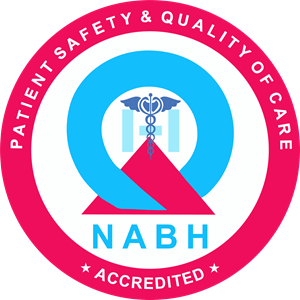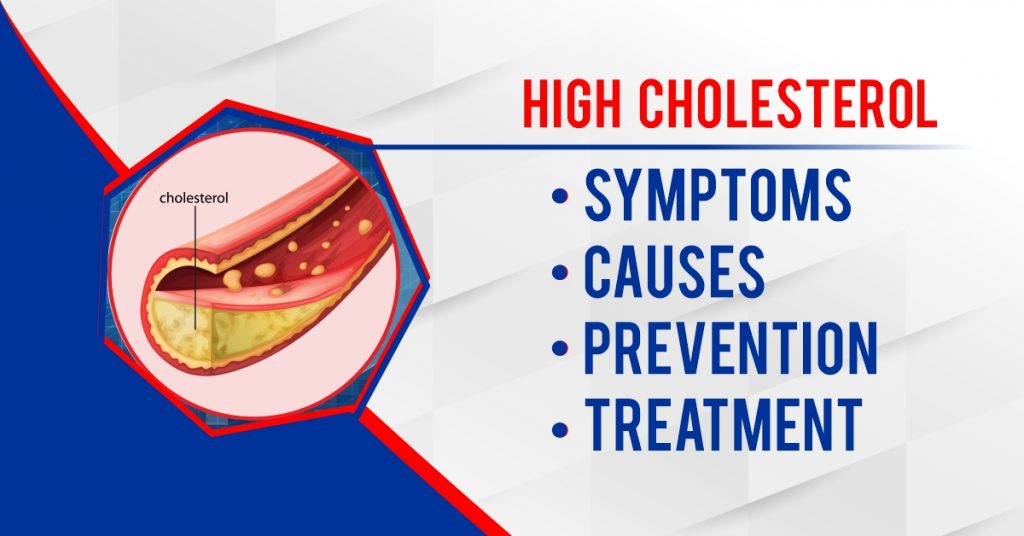What is high Cholesterol?
High Cholesterol is a vital substance that plays an important role in maintaining overall body function. It is a waxy, fat-like compound produced naturally by the liver and also obtained from certain foods. Cholesterol supports the formation of cell membranes, hormones, and vitamin D, making it essential for normal health. However, when cholesterol levels become imbalanced, it can lead to serious health concerns, particularly those affecting the heart and blood vessels. Understanding cholesterol is the first step toward preventing related complications and maintaining long-term cardiovascular health.
Types of Cholesterol:
Cholesterol can be divided into two types:
- LDL cholesterol (low-density lipoprotein)
- HDL cholesterol (high-density lipoprotein cholesterol).
LDL Cholesterol:
LDL is also termed bad cholesterol. The problem with having too much LDL cholesterol is that it accumulates in the arteries (the blood vessels which carry blood and oxygen throughout the body).
On the walls of the arteries, plaque is formed due to the build-up of cholesterol. As a result, arteries can be blocked, resulting in heart attacks and strokes. As a result, arteries can be blocked, resulting in heart attacks and strokes.
HDL Cholesterol:
High-density lipoprotein (HDL) cholesterol is good cholesterol. It functions as a cleaner, flushing out LDL cholesterol from the arteries to your liver, where it is broken down and used by the body.
As the liver makes cholesterol, it resembles fat. Among its functions are
- Involved in the formation of bile acids, which facilitate the digestion of fats
- Steroid hormones are precursors to thyroid hormones
- Exposure to sunlight increases the skin’s production of vitamin D
- Having a major impact on the health of cell membranes
High Cholesterol:
When your blood contains too much bad cholesterol (LDL) or not enough good cholesterol (HDL), you have high cholesterol.
Depending on your heart disease risk, your ideal cholesterol level will vary.
- It is best to keep your cholesterol level below 200, but it also depends on your HDL and LDL levels.
- Less than 130 is desirable when it comes to LDL cholesterol, but it depends on your risk factor for heart disease.
- Your risk for heart disease reduces if your HDL cholesterol level is 60 or higher.
- It’s best if you have a triglyceride level under 150 mg/dl.
You Can Read Also: Aspergillosis: Types, Causes, Symptoms, Diagnosis & Treatment
Causes and Risk Factors of High Cholesterol:
The Centers for Disease Control and Prevention say that several factors contribute to high cholesterol, including the following.
Heredity: You are also more likely to have high cholesterol if you have a family history of high cholesterol or heart disease.
It is also possible for some people to suffer from an extremely rare genetic condition called familial hypercholesterolemia, which causes extremely high levels of LDL at a young age and leads to heart attacks and coronary artery disease in the future.
Age: Every person’s risk of having high cholesterol rises with age because of changes in metabolism, including how the liver removes LDL cholesterol from the blood.
Gender: A woman over age 55 or after menopause tends to have lower rates of LDL cholesterol than a man. A woman’s HDL cholesterol level tends to be higher than a man’s.
Diet: High-cholesterol diets tend to contain saturated fat, cholesterol, and trans fats. Many dairy products, such as meat and dairy products that contain full-fat, and certain oils that are solid at room temperature have high saturated fat content. After discovering that dietary cholesterol did not significantly contribute to heart disease risk, the WHO no longer specifically discourage dietary cholesterol consumption. It is considered the best way to lower your cholesterol to reduce the amount of saturated and trans fat in your diet.
Level of Physical Activity: Physical inactivity in everyday life may lower HDL cholesterol, reducing the body’s ability to clear LDL cholesterol from the arteries, as suggested by the WHO. Increasing HDL cholesterol levels and reducing LDL cholesterol particle size is possible with moderate to intense exercise.
Tobacco Use: Smoking causes blood vessels to become damaged and lowers HDL cholesterol, which lowers the risk of heart disease, particularly in women. Tobacco smoking does not increase the level of LDL cholesterol, but it does promote fatty plaque buildup by creating an arterial environment.
Obesity: It has been documented that obesity can increase triglycerides, HDL cholesterol, and LDL cholesterol. People with a low BMI can develop high cholesterol, too, even if they are considered overweight or obese according to the BMI scale.
Diabetes: In Type 2, the level of HDL cholesterol is lower and the level of LDL cholesterol is higher because of factors related to lifestyle, weight, and metabolism. Various factors may contribute to this relationship, including insulin metabolism changes and overall inflammation, according to a study. In addition to having higher lipid levels in people with type 1, even if their overall levels are normal, they will be more likely to develop heart disease.
Symptoms of High Cholesterol:
It is not unusual for high cholesterol to cause no obvious symptoms. The condition doesn’t show any warning signs as high blood pressure does. The problem is usually discovered during a routine blood test and physical examination.
A high cholesterol level can cause symptoms. A narrowed artery in the legs can cause angina and pain in the calves. High cholesterol is a major cause of heart disease and stroke. High cholesterol is a major cause of heart disease and stroke.
Atherosclerosis may develop as a result of high cholesterol over time. It causes plaque to accumulate in the blood vessels. Plaque blockages can obstruct blood flow, causing:
- heart attack
- stroke
- chest pain
- Less blood flow in legs
Diagnosis of Cholesterol:
Symptomless high cholesterol needs to be detected by a simple blood test called a lipid profile, or lipid panel because it rarely presents any symptoms. Before your blood is drawn, you may need to fast (not eat or drink) for 8 to 12 hours.
This blood sample allows your doctor to measure your LDL cholesterol, HDL cholesterol, and triglycerides. Triglycerides can add to low HDL or high LDL to increase your heart attack risk. In addition to determining your total cholesterol, a lipid panel can also report your lipid profile.
Adults should strive for the following levels for each component:
- LDL should be less than 100 mg/dL
- More than 60 milligrams of HDL cholesterol
- Less than 150 milligrams of triglycerides
- Least 200 mg/dL total cholesterol
Yet, more and more cardiologists are emphasizing the overall risk of heart disease rather than specific numbers. If you have high cholesterol levels but they’re not within the desirable range, your doctor can advise you based on your age and overall health.
Treatment of High Cholesterol:
To lower cholesterol, doctors prescribe several types of medications.
-
- LDL cholesterol is reduced and the liver can remove this substance more efficiently when these drugs are taken.
- Niacin boosts HDL cholesterol and lowers LDL cholesterol.
- Bile acid sequestrants. They help reduce cholesterol levels by removing bile acids from the body.
- Injectable medicines. They are mainly prescribed for people with genetic conditions that cause high levels of LDL cholesterol.
- As a newer type of medicine, PCSK9 inhibitors reduce LDL cholesterol by binding to and inactivating a protein on certain liver cells. These drugs are usually administered by injection to patients with high cholesterol who do not respond to statins or persons with familial hypercholesterolemia.
- Generally, selective cholesterol absorption inhibitors prevent cholesterol from being absorbed in the intestinal tract and are the most commonly used nonstatin drugs. By doing this, less cholesterol will end up in the liver and blood.
Prevent High Cholesterol:
Genetically affected by this problem can not be controlled. Fortunately, lifestyle factors can be controlled. You can lower your cholesterol risk by doing the following:
- Diet for a healthy heart: Dietary foods that contribute to heart health include fruits, vegetables, whole grains, nuts, fish, poultry, low-fat dairy products, and nontropical vegetable oils. It also requires limiting foods high in salt and sugar, as well as red and processed meats.
- Exercise regularly: Getting insufficient physical activity lowers HDL cholesterol, which raises LDL cholesterol. Exercise at a moderate intensity for at least 150 minutes a week can lower total cholesterol and blood pressure.
- Quit smoking: Those who smoke with high cholesterol have an increased risk of developing coronary artery disease. It has been shown that quitting smoking raises HDL cholesterol and lowers LDL cholesterol.
- Reach or maintain a moderate weight: Increased body weight and obesity lower HDL cholesterol and increase LDL cholesterol. It is possible to lower cholesterol levels by losing just 5–10% of body weight.
Conclusion
High cholesterol is a silent but serious condition that can significantly increase the risk of heart disease and stroke if not properly managed. Awareness of cholesterol types, regular screening, and timely lifestyle changes are key to prevention and control. Seeking expert medical care at a trusted Jaipur hospital ensures accurate diagnosis, personalised treatment, and ongoing guidance. With the right medical support, healthy habits, and consistent monitoring, individuals can effectively manage cholesterol levels and protect their long-term heart health.


